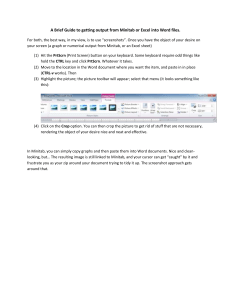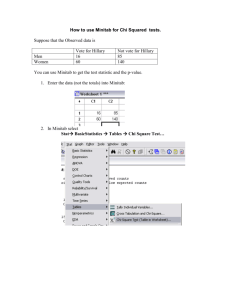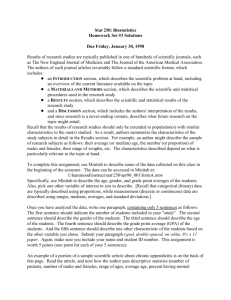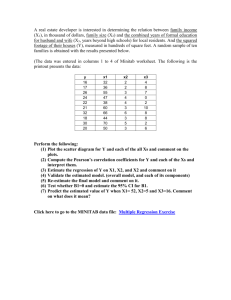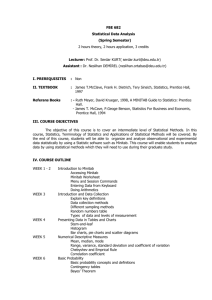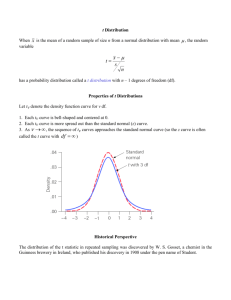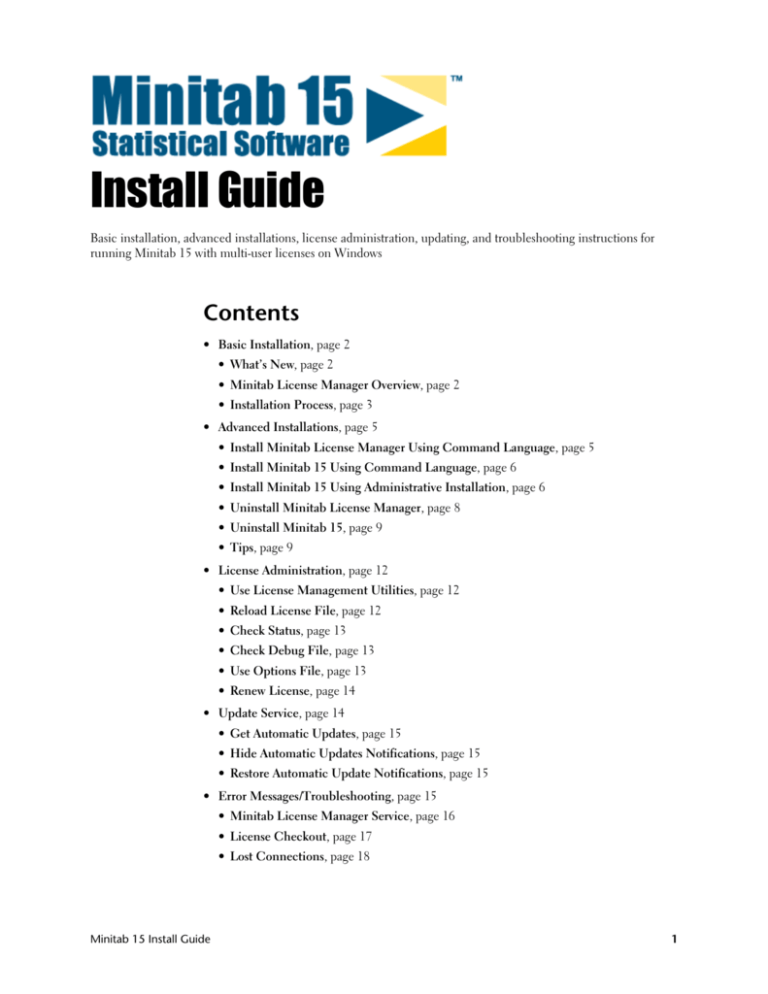
Install Guide
Basic installation, advanced installations, license administration, updating, and troubleshooting instructions for
running Minitab 15 with multi-user licenses on Windows
Contents
• Basic Installation, page 2
• What’s New, page 2
• Minitab License Manager Overview, page 2
• Installation Process, page 3
• Advanced Installations, page 5
• Install Minitab License Manager Using Command Language, page 5
• Install Minitab 15 Using Command Language, page 6
• Install Minitab 15 Using Administrative Installation, page 6
• Uninstall Minitab License Manager, page 8
• Uninstall Minitab 15, page 9
• Tips, page 9
• License Administration, page 12
• Use License Management Utilities, page 12
• Reload License File, page 12
• Check Status, page 13
• Check Debug File, page 13
• Use Options File, page 13
• Renew License, page 14
• Update Service, page 14
• Get Automatic Updates, page 15
• Hide Automatic Updates Notifications, page 15
• Restore Automatic Update Notifications, page 15
• Error Messages/Troubleshooting, page 15
• Minitab License Manager Service, page 16
• License Checkout, page 17
• Lost Connections, page 18
Minitab 15 Install Guide
1
Basic Installation
What’s New
MINITAB® and all other trademarks and logos for the Company's products and services are the
exclusive property of Minitab Inc. All other marks referenced remain the property of their
respective owners. See minitab.com for more information.
© 2006 Minitab Inc. All rights reserved.
Basic Installation
This section provides basic instructions for installing Minitab 15 in environments covered by
a multi-user license. These instructions do not apply to unit copies. Instructions for installing
unit copies are printed on the CD. The installation procedures have changed significantly
since the last release of this software. Please read this entire section before installing. The
intended audience for this install guide is system administrators; however, users who manage
their own installations can also use it.
What’s New
In response to customer requests, Minitab 15 contains three new features that impact
installation:
• Minitab License Manager
• Administrative installation
• Update service
The Minitab License Manager powered by FLEXnet™, the software industry’s leading
license management application, allows you to control the number of concurrent users
allowed to access Minitab 15 at your site. Typically, the Minitab License Manager resides on
a machine in the network, and Minitab 15 is installed to client machines that have network
connectivity to the license manager machine. However, for stand-alone arrangements, the
Minitab License Manager can be installed to the same client machine as Minitab 15. (The
Minitab 15 application must always be installed to a client machine.)
The Minitab administrative installation saves you time when installing Minitab 15 to client
machines by using a server installation image. You only need to enter license information
once into the image, then use the deployment method of your choice to install Minitab 15
from the server installation image to client machines.
The update service ensures you get the proper updates in a timely manner. Through the
update service, users are automatically notified of updates and can install them (provided they
have the appropriate permissions), as well as hide and restore update notifications. However, if
all users must remain on the same version of the Minitab product, you can disable the update
service using one of our advanced installation methods.
Minitab
License
Manager
Overview
The Minitab License Manager allows software licenses to be available (or float) anywhere on
a network, instead of being tied to specific machines. Floating licenses benefit both users and
license administrators. Users make more efficient use of fewer licenses by sharing them on the
network. License administrators can control the number of users who use Minitab 15 and
make sure their organization complies with the license agreement.
The Minitab License Manager must be installed on a machine prior to running Minitab 15,
and Minitab 15 must be installed on client machines that have network connectivity to the
license manager machine. When a user starts the application, it communicates with the
license manager to determine if a license is available from the pool of network licenses. If a
license is available, permission to use the application is granted or denied. Here are more
details about the licensing system components:
2
Minitab 15 Install Guide
Installation Process
Installation
Process
Basic Installation
Component
File Name
Role
Minitab 15
mtb.exe
Minitab 15 on the client looks for the license file
on the network.
Minitab license file
minitab.lic
The license file contains Minitab licensing
information.
Minitab License Manager
lmgrd.exe
Using the information in the license file, the
application communicates with the license
manager specifying which daemon is
associated with the application.
Minitab daemon
minitab.exe
The application then communicates with the
Minitab daemon. The Minitab daemon keeps
track of the number of licenses available and
grants or denies access to the application.
The Minitab 15 installation is a three-step process:
1 Install the Minitab License Manager.
2 Start the Minitab License Manager service.
3 Install Minitab 15 on client machines.
Install Minitab License Manager
You must install the Minitab License Manager prior to running Minitab 15. Before beginning
the installation, you should:
• Verify the machine on which you plan to install the Minitab License Manager has the
appropriate system requirements, which include the Windows operating system. The latest
system requirements for Minitab products can be found by going to http://
www.minitab.com/products and following the links for the software product and system
requirements.
• Have the license file you received from Minitab. If you do not have a license file, please
refer to the entitlement correspondence that your licensing coordinator received. This
correspondence contains instructions for initiating the entitlement fulfillment process. As
part of this process, you must identify the machine on which you will install the license
manager (referred to as the license manager machine). Additional documentation on the
entitlement process can be found at http://www.minitab.com/support/docs.
• Make sure client machines have network connectivity to the license manager machine.
• Have administrator privileges on the license manager machine.
• Disable virus-checking software and network-security applications on the license manager
machine during the entire installation process. Remember to enable these applications
after the installation is complete.
To install using the installation interface, perform the following steps:
1 If installing from the installation CD, insert the disk into the CD-ROM drive of the license
manager machine.
2 From the Windows Taskbar of the license manager machine, choose Start ➤ Run.
3 Type the path to the installation files followed by \License Manager\Setup.exe (for
example, D:\License Manager\Setup.exe).
4 Click OK.
Minitab 15 Install Guide
3
Basic Installation
Installation Process
5 Follow the prompts on the screen. During the installation, you will:
• Accept the default installation location or choose a different folder.
• Accept the default license file location (recommended) or choose a different folder.
6 After installing, copy the license file (minitab.lic) to the license file location you specified
during installation.
Note
To install the Minitab License Manager using command language, see Install Minitab License Manager
Using Command Language, on page 5. For advanced configurations, such as redundant license machines
or multiple FLEXenabled™ applications, please refer to the FLEXnet Licensing End User Guide distributed by
Macrovision (www.macrovision.com).
Start the Minitab License Manager service
The Minitab License Manager is installed as a service. This assures that the license manager
gets started automatically at system-boot time. However, you must start the service manually
the first time after you install.
1 Using the license manager machine, choose Start ➤ Settings ➤ Control Panel ➤
Administrative Tools ➤ Services.
Note: On older operating systems, this may be Start ➤ Settings ➤ Control Panel ➤
Services.
2 In the Services control panel, scroll through the list of services and right-click Minitab
License Manager. From the menu, choose Start.
Note: If you need to stop the service, you would follow the same steps but choose Stop
from the menu.
Install Minitab 15 on the client machines
Before beginning the Minitab 15 installation, you should:
• Verify client machines have the appropriate system requirements. The latest system
requirements for Minitab products can be found by going to http://www.minitab.com/
products and following the links for the software product and system requirements.
• Assign appropriate user permissions. For administrative installations, users need elevated
privileges to the server installation image. For other installations, users need elevated or
local administrative privileges to client machines to install or update the software.
• Disable virus-checking software on client machines during the entire installation process.
Remember to enable these applications after the installation is complete.
• If you use a custom profile, have the pre-install profile ready to copy it to the client
machine or include it with the installation files. See Tips, on page 9.
To install using the installation interface, perform the following steps:
1 If installing from the installation CD, insert the disk into the CD-ROM drive of the client
machine.
2 From the Windows Taskbar of the client machine, choose Start ➤ Run.
3 Type the path to the installation files followed by \Setup.exe (for example, D:\Setup.exe).
4 Click OK.
5 Follow the prompts on the screen. During the installation, you will:
• Accept the terms of the license agreement.
4
Minitab 15 Install Guide
Install Minitab License Manager Using Command Language
Advanced Installations
• Accept the default installation folder (C:\Program Files\Minitab 15) or choose a
different folder.
• Enter the port number and machine name of the license manager machine with the
following syntax: portnumber@machinename (for example 27000@Hal). The Minitab
License Manager uses port number 27000 unless you have specified another port
number in the SERVER line of the license file or have multiple license managers
installed.
• Determine if you want a shortcut to Minitab 15 on the desktop.
Note
To install Minitab 15 using the administrative installation, see Install Minitab 15 Using Administrative
Installation, on page 6. To install Minitab 15 using command language, see Install Minitab 15 Using
Command Language, on page 6.
After installing Minitab 15, you should:
• If you installed directly from the installation CD and you have a pre-install profile, copy
the profile to Minitab 15\English\Profiles folder before opening Minitab for the first time.
If you included the profile with the installation files, the installation has done this for you.
• If you have a firewall between the client machines and the license manager machine, you
may need to manually open access to the port for the license manager (lmgrd.exe). Use the
interface of your firewall to open the port number you specified during installation.
Advanced Installations
This section provides information on performing the following actions:
• Install the Minitab License Manager using command language
• Install Minitab 15 using command language
• Install Minitab 15 using an administrative installation
• Uninstall the Minitab License Manager
• Uninstall Minitab 15
• Tips
Before proceeding with any of the instructions below, please read Basic Installation, on page
2 for important before-and-after-installation information.
Install
Minitab
License
Manager
Using
Command
Language
You can use command language to install the Minitab License Manager on the license
manager machine. To do so, you must specify the installation location and the path to the
license file using the appropriate command language syntax.
From the license manager machine, execute the following command language as one
continuous line of text, substituting your information for italicized text:
• msiexec.exe /i
• "path to installation files\License Manager\Minitab License Manager.msi" /qn
• INSTALLDIR="path to where you want to install the license manager" (If you do not
specify a location, the Minitab License Manager uses C:\Program Files\Minitab\License
Manager.)
Minitab 15 Install Guide
5
Advanced Installations
Install Minitab 15 Using Command Language
• LICENSEDIR="path to location of the license file" (If you do not specify a location, the
Minitab License Manager uses C:\Program Files\Minitab\License Manager. We
recommend you use the default location.)
Your command language might appear similar to this example without line breaks:
msiexec.exe /i "D:\License Manager\Minitab License Manager.msi" /qn
INSTALLDIR="C:\Program Files\Minitab\License Manager"
LICENSEDIR="C:\Program Files\Minitab\License Manager"
Install
Minitab 15
Using
Command
Language
You can use command language to install Minitab 15 on the client machine. To do so, you
must specify the license information for each install using the appropriate command language
syntax.
From the client machine, execute the following command language as one continuous line of
text, substituting your information for italicized text:
• msiexec.exe /i
• "path to installation files\Minitab 15 language.msi" /qn
• MINITAB_LICENSE_FILE="portnumber@machinename" (By default, the Minitab
License Manager uses port number 27000 unless you have specified another port number
in the SERVER line of your license file or have multiple license managers installed.)
• INSTALLDIR="path to where you want to install application" (If you do not specify a
location, Minitab 15 uses C:\Program Files\Minitab 15.)
• DEFFILELOC="path to Minitab’s working directory" (If you do not specify a location,
Minitab 15 uses the My Documents folder in the current user’s profile. You can include
"UserProfile" at the beginning of the value, and Minitab 15 will translate it to be the
current user’s profile, C:\Documents and Settings\username.)
• SHORTCUT="1" to install the desktop shortcut or SHORTCUT="" to not install.
(Minitab 15 installs the desktop shortcut by default.)
• UPDATE="1" to enable the update service or UPDATE="" to disable. (Minitab 15
enables the update service by default.)
Your command language might look similar to this example without line breaks:
msiexec.exe /i "D:\Minitab 15 English.msi" /qn
MINITAB_LICENSE_FILE="27000@Hal" INSTALLDIR="C:\Program Files\Minitab
15" DEFFILELOC="UserProfile\My Documents" SHORTCUT="1" UPDATE="1"
Install
Minitab 15
Using
Administrative
Installation
You can create a server installation image on the network and deploy Minitab 15 to clients by
running the server installation image. You only need to specify the license information one
time when creating the server installation image.
You can create the server installation image in one of two ways:
• Use the administrative installation interface
• Use command language
After creating the server installation image, you can deploy Minitab 15 in at least one of two
ways:
• Use the server installation image interface
• Use command language
6
Minitab 15 Install Guide
Install Minitab 15 Using Administrative Installation
Advanced Installations
Create server installation image using the interface
To create the server installation image using the interface, perform the following steps:
1 If installing from the installation CD, insert the disk into the CD-ROM drive of your
workstation.
2 Execute the following command language as one continuous line of text, substituting our
information for italicized text:
msiexec.exe /a "path to installation files\Minitab 15 language.msi"
Your command language might look similar to this example:
msiexec.exe /a "D:\Minitab 15 English.msi"
3 Follow the prompts provided by the dialog boxes. During the installation, you will:
• Enter the network location where you want to store the server installation image.
• Enter the port number and machine name of the license manager machine with the
following syntax: portnumber@machinename (for example 27000@Hal).
• Determine if you want a shortcut to Minitab 15 on the desktop.
• Determine if you want to enable the update service.
Create server installation image using command language
To create the server installation image, execute the following command language as one
continuous line of text, substituting your information for italicized text:
• msiexec.exe /a
• "path to installation files\Minitab 15 language.msi" /qn
• MINITAB_LICENSE_FILE="portnumber@machinename" (By default, the Minitab
License Manager uses port number 27000 unless you have specified another port number
in the SERVER line of your license file or have multiple license managers installed.)
• TARGETDIR="path to where you want to create server installation image"
• DEFFILELOC="path to Minitab’s working directory" (If you do not specify a location,
Minitab 15 uses the My Documents folder in the current user’s profile. You can include
"UserProfile" at the beginning of the value, and Minitab 15 will translate it to be the
current user’s profile, C:\Documents and Settings\username.)
• SHORTCUT="1" to install the desktop shortcut or SHORTCUT="" to not install.
(Minitab 15 installs the desktop shortcut by default.)
• UPDATE="1" to enable the update service or UPDATE="" to disable. (Minitab 15
enables the update service by default.)
Your command language might look similar to this example without line breaks:
msiexec.exe /a "D:\Minitab 15 English.msi" /qn
MINITAB_LICENSE_FILE="27000@Hal" TARGETDIR="\\Server1\Shared
Image\Minitab 15" DEFFILELOC="UserProfile\My Documents" SHORTCUT="1"
UPDATE="1"
Minitab 15 Install Guide
7
Advanced Installations
Uninstall Minitab License Manager
Deploy using the interface
To deploy from the server installation image using the interface, perform the following steps:
1 From the client machine, navigate to the server installation image you created on the
network.
2 Double-click the .MSI file.
3 Follow the prompts on the screen. During the course of the installation, you will:
• Accept the terms of the license agreement.
• Accept the default installation folder (C:\Program Files\Minitab 15) or choose a
different folder.
Deploy using command language
From the client machine, execute the following command language as one continuous line of
text, substituting your information for italicized text:
• msiexec.exe /i
• "path to server installation image\Minitab 15 language.msi" /qn
• optional property INSTALLDIR
Your command language might look similar to this example without line breaks:
msiexec.exe /i "\\Server1\Shared Image\Minitab 15\Minitab 15 English.msi" /qn
INSTALLDIR="C:\Program Files\Minitab 15"
Uninstall
Minitab
License
Manager
Before you uninstall the Minitab License Manager, you must stop the service. See Installation
Process on page 3. You can uninstall in one of three ways:
• Use the Minitab License Manager’s installation interface
• Use command language containing the .MSI file
• Use command language containing a GUID
Uninstall using interface
From the license manager machine, choose Start ➤ Settings ➤ Control Panel ➤ Add or
Remove Programs, and then uninstall the Minitab License Manager.
Uninstall using command language with .MSI file
From the license manager machine, execute the following command language as one
continuous line of text, substituting your information for italicized text:
msiexec.exe /x "path to installation files\License Manager\Minitab License Manager.msi" /qn
Your command language might look similar to this example without line breaks:
msiexec.exe /x "D:\License Manager\Minitab License Manager.msi" /qn
Uninstall using command language with GUID
If the .MSI file is not available, you can use a GUID in the command instead of the file. This
GUID is specific to the Minitab License Manager installed:
Language
8
Command Language with GUID
Minitab 15 Install Guide
Uninstall Minitab 15
Uninstall
Minitab 15
Advanced Installations
English
msiexec.exe /x {831EA8D2-5495-4F20-BF61-351BE71CAB32} /qn
French
msiexec.exe /x {51E2D6D8-A0E3-4398-AD2E-1639E7F27A7F} /qn
German
msiexec.exe /x {AD0BA6E7-21FB-4BFD-8469-81C49313E215} /qn
Chinese
msiexec.exe /x {DCC47DFF-57A2-4FFE-849F-ABDD907AAB9C} /qn
You can uninstall Minitab 15 from the client machine in one of three ways:
• Use the installation interface
• Use command language containing the .MSI file
• Use command language with a GUID
Uninstall using interface
On the client machine, choose Start ➤ Settings ➤ Control Panel ➤ Add or Remove
Programs, and then uninstall Minitab 15.
Uninstall using command language with .MSI file
From the client machine, execute the following command language as one continuous line of
text, substituting your information for italicized text:
msiexec.exe /x "path to server installation image or path to installation files\Minitab 15
language.msi" /qn
Your command language might look similar to this example without line breaks:
msiexec.exe /x "D:\Minitab 15 English.msi" /qn
Uninstall using command language with GUID
If the .MSI file is not available, you can use a GUID in the command instead of the file. This
GUID is specific to the Minitab product installed:
Tips
Language
Command Language with GUID
English
msiexec.exe /x {0FAED7DC-4206-4F84-9A46-0ED6D5B623B8} /qn
French
msiexec.exe /x {59379921-52F3-4E67-BD3E-FB105526BA14} /qn
German
msiexec.exe /x {B61F6A8E-893B-4A42-9153-08BA8C07B693} /qn
Chinese
msiexec.exe /x {3A6C497E-D6A5-4E54-8F89-05613E346C3F} /qn
This section provides useful installation tips:
• Execute command language
• Generate an installation log file
• Change the option to enable or disable updates
• Create identical settings on multiple machines
• Find online installation resources
Execute command language
You can use at least one of two ways to execute command language:
• Use the Run dialog box
Minitab 15 Install Guide
9
Advanced Installations
Tips
• Create a batch file
To execute command language from the Run dialog box, perform the following steps:
1 From the Windows Taskbar, choose Start ➤ Run.
2 In Open, type in the command language in one continuous line of text.
3 Click OK.
Note
The Run dialog box is a simple way to execute commands; however, it has a 255-character limit and may
not be suitable for all operations.
To create and execute a batch file, perform the following steps:
1 Open a new file in a text editor, such as Notepad.
2 Type in the command language.
3 Save the file choosing All Files for the file type. Type the name of the file in quotation
marks with .BAT extension (for a batch file).
4 From the appropriate machine, locate the batch file and double-click the batch file. A
DOS Command Prompt window opens during execution.
Generate an installation log file
If you are having trouble installing, you can use command language to generate a log file.
This file can be attached to an e-mail and sent to Technical Support, so Minitab can assist you
more efficiently in resolving your problem. To generate the log file, add the following
command language after the /i or /a command, beginning with a space and in one continuous
line of text:
/L*v "%TEMP%\MTB15SetupLog.txt"
Your command language might look similar to this example without line breaks:
msiexec.exe /i "\\Server1\Shared Image\Minitab 15\Minitab 15 English.msi" /qn
MINITAB_LICENSE_FILE="27000@ Hal" INSTALLDIR="C:\Program Files\Minitab
15" DEFFILELOC="UserProfile\My Documents" SHORTCUT="1" UPDATE="1" /L*v
"%TEMP%\MTB15SetupLog.txt"
To find the log file, perform the following steps:
1 From the Windows Taskbar of your workstation, choose Start ➤ Run.
2 Type %TEMP%.
3 Click OK.
4 Browse to MTB15SetupLog.txt.
Change the option to enable or disable updates
If you installed Minitab 15 and need to change the installation option for enabling or
disabling updates, you can do so without reinstalling the software:
1 If installing from the installation CD, insert the into the CD-ROM drive of the client
machine.
2 From the Windows Taskbar, choose Start ➤ Run.
3 Type the appropriate command:
10
Minitab 15 Install Guide
Tips
Advanced Installations
• To enable updates, type the path to the installation files followed by
\Tools\ToggleUpdates.exe ON (for example, D:\Tools\ToggleUpdates.exe ON).
• To disable updates, type the path to the installation files followed by
\Tools\ToggleUpdates.exe OFF (for example, D:\Tools\ToggleUpdates.exe OFF).
4 Click OK.
Create identical settings on multiple machines
Profiles in Minitab 15 store any changes to Minitab 15 factory default settings made using
Tools ➤ Options and Tools ➤ Customize, as well as custom date/time formats and
value-order settings. Each time you modify a setting, Minitab 15 stores the change in a user
profile so that it is in effect for the next Minitab session. All settings you change during a
session are stored in the uppermost profile located under Active Profiles in Tools ➤ Manage
Profiles.
To ensure that multiple machines have identical Minitab 15 settings, you can use Tools ➤
Manage Profiles to create and export a preinstall profile as a registry file named
ORGDEFS.REG and include it with the installation files:
• For administrative installations, store this file in the server installation image folder at the
same level as the .MSI file.
• For nonadministrative installations, copy the installation files to a network location and
store the preinstall file with the installation files before installing Minitab 15.
The installation places the file in the user’s Minitab 15\English\Profiles folder. If the
preinstall profile is not included with the installation files, you must copy it to each user’s
Minitab 15\Language\Profiles folder after installing but before opening Minitab 15 for the
first time. When a user opens Minitab 15 for the first time, the file is imported. The imported
profile is named $$ORGANIZATIONDEFAULTS, which shows up as the second profile in
Active Profiles. For more information on profiles, type Profiles in the Minitab 15 Help index.
To create a preinstall profile, perform the following steps:
1 Install Minitab 15 on any machine.
2 Open Minitab 15. Adjust any settings you want to share on multiple machines.
3 Choose Tools ➤ Manage Profiles.
4 Click
to move the profile MyProfile from Active profiles to Available profiles. (To be
exported, profiles must be under Available profiles.)
5 With the profile selected, click Export.
6 In Save In, browse to the network folder that contains the Minitab 15 installation files.
7 In File name, rename MyProfile to orgdefs.reg. Click Save.
Find online installation resources
The following online resources may be helpful to you:
• Microsoft MSIEXEC.EXE Command Line Options
http://msdn2.microsoft.com/en-us/library/aa372024.aspx
• Macrovision SETUP.EXE Command Line Options
http://support.installshield.com/kb/view.asp?articleid=Q105473
Minitab 15 Install Guide
11
License Administration
Use License Management Utilities
• Macrovision
http://www.macrovision.com
Note
Minitab does not maintain these sites and URLs are subject to change.
The latest install guides for Minitab products can be found at http://www.minitab.com/
support/docs.
License Administration
You can run Minitab 15 with minimal interaction with the Minitab License Manager.
However, to manage the license system, you may want to know how to do the following
actions:
• Use license management utilities
• Reload license file
• Check status
• Check debug file
• Use options file
• Renew license
Use License
Management
Utilities
Macrovision provides utilities for performing license management tasks. We distribute these
utilities to you in the license manager folder:
• lmtools.exe
• lminstall.exe
• lmremove.exe
• lmstat.exe
• lmreread.exe
The lmtools.exe utility provides a graphical user interface to access all the license
management tasks. To use LMTOOLS, navigate to the license manager folder and
double-click lmtools.exe to display the interface.
If you prefer to use command language, the other utilities provide access to the different
license management tasks provided with LMTOOLS. To use these utilities, you must open a
DOS Command Prompt window, go to the license manager folder, and execute the
appropriate utility command.
For more information on using these utilities, please refer to FLEXnet Licensing End User
Guide distributed by Macrovision (www.macrovision.com).
Reload
License File
If you change the license file, you need to reload it so the license manager can recognize the
changes.
To reload the license file using LMTOOLS, perform the following steps:
1 Navigate to the license manager folder and double-click lmtools.exe.
2 Click the Start/Stop/Reread tab.
12
Minitab 15 Install Guide
Check Status
License Administration
3 In FLEXnet license services installed on this computer, ensure the license service is
highlighted.
4 Click ReRead License File.
To reload the license file using LMREREAD, open a DOS Command Prompt window, go to
the license manager folder, and execute the following command:
lmreread -vendor minitab
Check Status
You can check the status of the license manager to help you monitor network licensing
activities, such as the number of licenses in use and who is using them.
To check the status using LMTOOLS, perform the following steps:
1 Navigate to the license manager folder and double-click lmtools.exe.
2 Click the Server Status tab.
3 Click Perform Status Enquiry.
To check status using LMSTAT, open a DOS Command Prompt window, go to the license
manager folder, and execute the following command:
lmstat -a
Check Debug
File
The Minitab License Manager produces a debug file. The debug log file contains status and
error messages useful for debugging, such as to whom and when licenses were checked out,
checked in, or denied. The Minitab License Manager’s debug file, minitab.dl, is located in
the license manager folder. To read this file, open it in a text editor, such as Notepad.
For more information on the debug log file, please refer to the FLEXnet Licensing End User
Guide distributed by Macrovision (www.macrovision.com).
Use Options
File
You do not need an options file. However, you might want to use some options to control
various license system options, such as allowing features, denying features, reserving licenses,
restricting the number of licenses, or controlling the amount of information logged about
license usage. To create an options file, perform the following steps:
Note: This procedure involves modifying the license file after you have created the options
file. Before beginning, we recommend you make a backup version of the license file.
1 Open a new file in any text editor, such as Notepad.
2 Use the appropriate options and the syntax documented in the FLEXnet Licensing End
User Guide distributed by Macrovision (www.macrovision.com) to construct your options.
3 Save the options file to the same folder as the license file and give it the name
“minitab.opt”.
4 In the text editor, navigate to and open minitab.lic.
5 To the end of the VENDOR line, add a space and options="minitab.opt". Options must be
in lowercase characters because the license file is case-sensitive.
6 Save the file.
7 Reload the license file. See Reload License File, on page 12.
Example of options file:
Minitab 15 Install Guide
13
Update Service
Renew License
# You can include comments in your options file by starting the line with the pound sign.
# Option files are restricted to 2048 characters.
# Each line of the file controls one option.
# Excludes Tom Jones from using Minitab
EXCLUDE Minitab USER tjones
Example of license file referencing options file:
SERVER this_host host_id
VENDOR minitab options="minitab.opt"
USE_SERVER
INCREMENT Minitab….
Renew
License
If you are renewing or adding users to your license, you will receive text from Minitab
(starting with the keyword INCREMENT) to append to the end of the existing license file:
Note: Before beginning, we recommend you make a backup version of the license file.
1 From your Minitab correspondence, copy everything from the start of the word
INCREMENT to the end of the text.
2 Open a text editor, such as Notepad.
3 In the text editor, navigate to and open minitab.lic.
4 Go to the end of the file and start a new line.
5 On the new line, paste the new text.
6 Save the file.
7 Reload the license file. See Reload License File on page 12.
SERVER this_host host_id
VENDOR minitab
USE_SERVER
100
original
users
10
additional
users
INCREMENT Minitab minitab 15.1 30-nov-2006 100 XXXXXXX
XXXXXXXXXXXXXXXXXXXXXXXXXXXXXXX
XXXXXXXXXXXXXXXXXXXXXXXXXXXXXXX
XXXXXXXXXXXXXXXXXXXXXXXXXXXXXXX
INCREMENT Minitab minitab 15.1 30-nov-2006 10 XXXXXXX
XXXXXXXXXXXXXXXXXXXXXXXXXXXXXXX
XXXXXXXXXXXXXXXXXXXXXXXXXXXXXXX
XXXXXXXXXXXXXXXXXXXXXXXXXXXXXXX
Update Service
If you wish to control Minitab 15 updates, you should disable updates during installation. If
you disable this function, you can have a separate installation with updates enabled to
periodically check for them. If you disable software updates, the Update Manager will be
installed, but users will not receive any update notifications. If you enable software updates,
users must have the appropriate permissions to install the updates.
If you enabled software updates during the installation of the software, you will need to
educate your users on the following steps:
14
Minitab 15 Install Guide
Get Automatic Updates
Error Messages/Troubleshooting
• Get automatic updates
• Hide automatic update notifications
• Restore automatic update notifications
Get
Automatic
Updates
By default, when you start Minitab 15, if an update is available, the Update Manager
automatically opens. The Update Manager is a third-party utility that manages updates to the
software.
1 With the Update Manager open, look under New updates and messages to find the
update. You may see update notifications for several products or multiple updates for the
same product depending on the last time you updated.
2 Check the box next to the software update you want to install and then click Install. To
download the software and install it later, click Download Only.
Note: Different versions of the Update Manager may have slightly different interfaces.
3 During installation, you will be prompted to exit Minitab 15.
4 When the installation is finished, close the Update Manager and then restart Minitab 15.
Note
Hide
Automatic
Updates
Notifications
Alternatively, you can close the Update Manager without installing or downloading and check for updates
later by choosing Help ➤ Check for Updates from within Minitab 15.
You can hide the automatic update notifications so you do not see them every time you start
Minitab 15.
1 With the Update Manager open, look under New updates and messages to find the
update.
2 Click the update notification text (not the checkbox). You will see text appear below the
update notification.
3 Click Don’t show this update again. The update notification disappears from the list.
Note
Restore
Automatic
Update
Notifications
When you hide update notifications, you are hiding it for all users on the same machine. Until the
notification is restored, the Update Manager will behave as if no updates are available.
You can restore the automatic update notification so you can see them every time you start
Minitab 15.
1 Choose Start ➤ Settings ➤ Control Panel ➤ Program Updates to open the Update
Manager.
2 Click Restore hidden updates. The update notifications are listed under Restore hidden
updates.
3 Check the box next to the update notification you wish to restore.
4 Click Restore.
5 Click Check for Updates to see the updated list under New updates and messages. You
can now install the update.
Error Messages/Troubleshooting
This section covers troubleshooting tips for errors encountered with the following:
Minitab 15 Install Guide
15
Error Messages/Troubleshooting
Minitab License Manager Service
• Minitab License Manager service
• License checkout
• Lost connections
Minitab
License
Manager
Service
You might encounter any of the following Minitab License Manager issues:
• Cannot start service
• CPU usage 100% after starting service
• Debug file resets after restarting service
Problem: Cannot start service
If you cannot start the Minitab License Manager’s service, most likely you will get the
following error message:
The Minitab License Manager service on Local Computer started and then stopped. Some
services stop automatically if they have no work to do, for example, the Performance Logs and
Alerts Services.
Use the following table to troubleshoot the problem:
Question
Tip
Did you copy the license file (minitab.lic)
to the folder designated during the
Minitab License Manager installation?
Create the folder, if necessary, and copy the
license file to that location.
Can the Minitab License Manager create
the debug file (minitab.dl)?
The license manager creates a debug file
containing status and error messages. By default,
the file is in the license manager folder. Ensure
the account running the service has write access
to this folder.
Does the license manager machine have
For best results, install the Minitab License
non-ANSI characters in its machine name? Manager to a machine with only ANSI characters
in its name.
Have you installed the Minitab License
Manager on the machine for which the
license file (minitab.lic) was issued?
Your license file is issued for the machine you
registered as part of the fulfillment of your license
entitlement. Its host ID is part of the license file in
encrypted and unencrypted text and cannot be
changed. To check the host ID in the license file,
open the license file in a text editor such as
Notepad, and check the SERVER line:
SERVER this_host host_id
If you have installed the Minitab License Manager
to another machine, you can either reinstall the
license manager to the originally registered
machine, move the registered network card to
the new machine, or request that a new license
be issued that reflects the new machine. If you
have installed the Minitab License Manager on
the initially registered machine but the license file
is incorrect, please contact Minitab for a new
license file.
16
Minitab 15 Install Guide
License Checkout
Error Messages/Troubleshooting
Problem: Minitab daemon (minitab.exe) consumes 100% CPU usage after
starting service
The paths used during the installation may be too long (in excess of 256 characters). Uninstall
the Minitab License Manager (see Uninstall Minitab License Manager on page 8) and
reinstall it using shorter path names.
Problem: Debug file resets after restarting service
This debug file reset is expected behavior when running the Minitab License Manager as a
service. To change this behavior, run the Minitab License Manager as an application with the
following command line:
lmgrd -c "path and name of license file" -L +"path and name of debug log" -z
Your command language might look similar to this example without line breaks:
lmgrd -c "C:\Program Files\Minitab\License Manager\minitab.lic" -L +"C:\Program
Files\Minitab\License Manager\minitab.dl" -z
License
Checkout
If a user cannot check out a license from Minitab, the user will most likely get the following
error message:
FLEXnet License Error error_code: Check out failed.
Use the following table to troubleshoot the problem:
Question
Tip
Do you have a firewall between the
license manager machine and the client
machine running Minitab 15?
Firewalls can block communication between
Minitab 15 and the Minitab License Manager.
Ensure the license manager port is open between
both machines. If it is not open, use the interface
of your firewall to open the port number you
specified during installation.
Does the date differ in excess of 24 hours
between the client machine and the
license manager machine?
Reset the clock on the client machine. If the date
difference is greater than 24 hours, the Minitab
License Manager will refuse to grant the license.
Is the license manager machine name that
you provided during the Minitab 15
installation on the client machine valid?
If Minitab 15 cannot validate the machine name,
it prompts you for a valid machine name.
Can the client machine access the Minitab
License Manager?
Verify the client can reach the Minitab License
Manager (for example, use the telnet command
to query the license manager machine). If the
client cannot access the Minitab License
Manager, correct any routing or machine name
resolution issues.
Do you have an error code from the
FLEXnet License Error message?
You can refer to the FLEXnet Licensing End User
Guide distributed by Macrovision
(www.macrovision.com) for a description of error
codes that may help you debug the problem.
Have you checked the debug file?
The Minitab License Manager produces a debug
file (minitab.dl) containing status and error
messages that may help you debug the problem.
To view the debug file, see Check Debug File on
page 13.
Minitab 15 Install Guide
17
Error Messages/Troubleshooting
Have you checked the Event Viewer?
Lost
Connections
Lost Connections
The Minitab License Manager writes information
and error messages to the Windows Event-Log.
You can access it via Start ➤ Settings ➤ Control
Panel ➤ Administrative Tools ➤ Event Viewer.
These messages can help you troubleshoot
Minitab License Manager issues.
When the connection between Minitab 15 and the Minitab License Manager is lost, Minitab
15 displays the following error message:
FLEXnet License Error error_code: Connection to the license server has been lost. Minitab
will close after you are given the opportunity to save your work.
Save your work immediately and close Minitab 15.
If a user’s machine crashes or disconnects from the network while the user is running Minitab
15, the Minitab License Manager automatically checks in the license after two hours.
18
Minitab 15 Install Guide
Index
A
administrative installation
install Minitab 15 using
administrative installation 6
what’s new 2
advanced installations 5
B
basic installation 2
batch file 10
C
command language
execute command language 9
find online installation
resources 11
generate an installation log 10
install Minitab 15 using
administrative installation 6
install Minitab 15 using command
language 6
install Minitab License Manager
using command language 5
uninstall Minitab 15 9
uninstall Minitab License
Manager 8
D
daemon 3, 17
debug file
check debug file 13
error messages/
troubleshooting 16, 17
DEFFILELOC
install Minitab 15 using
administrative installation 7
install Minitab 15 using command
language 6
E
error messages/troubleshooting 15
Minitab 15 Install Guide
F
firewalls
error messages/
troubleshooting 17
install Minitab 15 on client
machines 5
FLEXnet 2
G
GUID
uninstall Minitab 15 using
command language with
GUID 8
uninstall Minitab License
Manager using command
language with GUID 8
I
image 6
INCREMENT 14
installation
install Minitab 15 on client
machines 4
install Minitab 15 using
administrative installation 6
install Minitab 15 using command
language 6
install Minitab License
Manager 3
install Minitab License Manager
using command language 5
installation process 3
start Minitab License Manager
service 4
tips 9
uninstall Minitab 15 9
uninstall Minitab License
Manager 8
INSTALLDIR
install Minitab 15 using
administrative installation 8
install Minitab 15 using command
language 6
install Minitab License Manager
using command language 5
L
license administration 12
license file
error messages/
troubleshooting 16
install Minitab 15 on client
machines 5
install Minitab 15 using
administrative installation 6
install Minitab 15 using command
language 6
install Minitab License
Manager 3
install Minitab License Manager
using command language 5
Minitab License Manager
overview 3
reload license file 12
renew license 14
use options file 13
license management utilities 12
LICENSEDIR 6
lmgrd.exe 3
lminstall.exe 12
lmremove.exe 12
lmreread.exe (LMREREAD)
reload license file 13
use license management
utilities 12
lmstat.exe (LMSTAT)
check status 13
use license management
utilities 12
lmtools.exe (LMTOOLS)
check status 13
reload license file 12
use license management
utilities 12
log file
check debug file 13
generate an installation log 10
M
Macrovision, find online installation
resources 12
Microsoft 11
Minitab 15 language.msi
Index
install Minitab 15 using
administrative install 7
install Minitab 15 using command
language 6
uninstall Minitab 15 using
command language with .MSI
file 9
Minitab License Manager
install 3
install using command
language 5
overview 2
uninstall 8
what’s new 2
Minitab License Manager service
error messages/
troubleshooting 16
start the service 4
Minitab License Manager.msi
install using command
language 5
uninstall using command
language with .MSI file 9
minitab.dl
check debug file 13
error messages/
troubleshooting 16
minitab.exe 3
error messages/
troubleshooting 17
Minitab License Manager
overview 3
minitab.lic
error messages/
troubleshooting 16
Minitab License Manager
overview 3
reload license file 12
use options file 13
minitab.opt 13
MINITAB_LICENSE_FILE
install Minitab 15 using
administrative installation 7
install Minitab 15 using command
language 6
msiexec.exe
install Minitab 15 using
administrative installation 7
install Minitab 15 using command
language 6
install Minitab License Manager
using command language 5
uninstall Minitab 15 9
uninstall Minitab License
Manager 8
Index
O
options file 13
P
profile (custom profile, pre-install
profile)
create identical settings on
multiple machines 11
install Minitab 15 on client
machines 4
profile (default profile, default file
location)
install Minitab 15 using
administrative installation 7
install Minitab using command
language 6
R
resources 11
Run dialog box 9
S
SERVER
error messages/
troubleshooting 16
install Minitab 15 on client
machines 4
install Minitab 15 using
administrative installation 7
install Minitab 15 using command
language 6
server installation image 6
service
error messages/
troubleshooting 16
start Minitab License Manager
service 4
update service 14
setup.exe
install Minitab 15 on client
machines 4
install Minitab License
Manager 3
SHORTCUT
install Minitab 15 using
administrative installation 7
install Minitab 15 using command
language 6
system requirements 4
T
TARGETDIR 7
ToggleUpdates.exe 11
troubleshooting/error messages 15
U
uninstall
Minitab 15 9
Minitab License Manager 8
UPDATE
install Minitab 15 using
administrative installation 7
install Minitab 15 using command
language 6
updates
change option to enable or disable
updates 10
update service 14
what’s new 2
V
VENDOR 13
virus-checking software
install Minitab 15 on client
machines 4
install Minitab License
Manager 3
W
what’s new 2
Minitab 15 Install Guide

